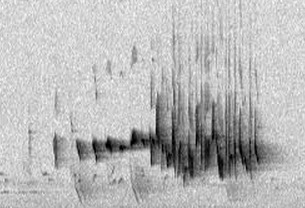Birdsong

Birds are more musical than people, to our shame. This fact has been a source of fascination throughout human history. We're aware that birds speak, and that they speak in a language we don't understand, but there has always been the sense that if we listen to them carefully enough perhaps we will understand... something.
One appeal of their song is that it seems so much like human language. And indeed it does move along at a language-like rate. The human perception of sound has a certain "blind spot" in it. Frequencies up to 5 to 10 Hz are understood and interpreted as pulses, rhythm, as sequences of distinct events. Above 20 or 30 Hz we no longer distinguish beats, but another mechanism takes over, and all we can perceive are the perceptual summaries that we know of as frequency and timbre. But at those rates just below what we hear as audio, in that "blind spot" just below that of detectable frequencies, there is a special band set aside, I believe, for the use of language. (Much like the way radio frequency bands are set aside for the use of television, FM radio, aviation communications and so on.)
This is the rate that phonemes stream by in listening to speech, and we have an entirely different perceptual apparatus for things at that frequency. It's not rhythm particularly, it's not frequency: it's the linguistic zone. The stream of timbral changes in birdsong takes place in that zone, and that's part of the reason why it speaks to us.
What are ears for? Sight, as Aristotle famously said, is prized above the other senses, and is more often the target of our focused attention than sound. Its primacy is perhaps expressed simply by the fact that our ears are on the sides of our heads, our eyes are on the front. But unlike our always directed sense of sight, our ears provide a channel of information that we receive whether we are attending to it or not. (We have eyelids, but no earlids.) Our ears bring us the speech of others, certainly; but more primally, they orient us in the world, and provide the atmosphere and overall moment of the environment in which we find ourselves. Sound orients us, both in social environments where language and our own music reinforces our sense of cultural belonging, and in natural environments where the sound of the wind and the movement of other animals alerts us to opportunities and dangers in our environment.
The tradition of augury -- taking the sound and behavior of birds as providing oracular communications to us -- is evidence of a special relationship we have long had with the birds as the other speakers in our world. Our observation of birds plays a special part in bridging the gap between the natural and the social. Though of the natural world, still they speak, and convey useful information about the environment we are in. Since they fly and travel long distances quickly, they know things about the larger picture that we cannot perceive directly, and their cries can report on, say, the presence of predators or of dangerous weather still a long ways off.
And, more mysteriously, their sounds just give us pleasure, the ambiance they provide reminding us continuously that we are embedded in a beautiful and living world.
The tools of computer and electronic music, for the first time in human history, have given us the ability to "hold" sounds, regard them as objects to polish, refine and sculpt. If anything I've said above has any validity, it seems obvious why some of us would be drawn to using these tools for the synthesis of bird sounds. Now that we can get our hands on mechanisms that create bird-like sounds, do we have a chance now to deepen our understanding of what they may have been saying?
-- Tim Perkis, Berkeley August 2010